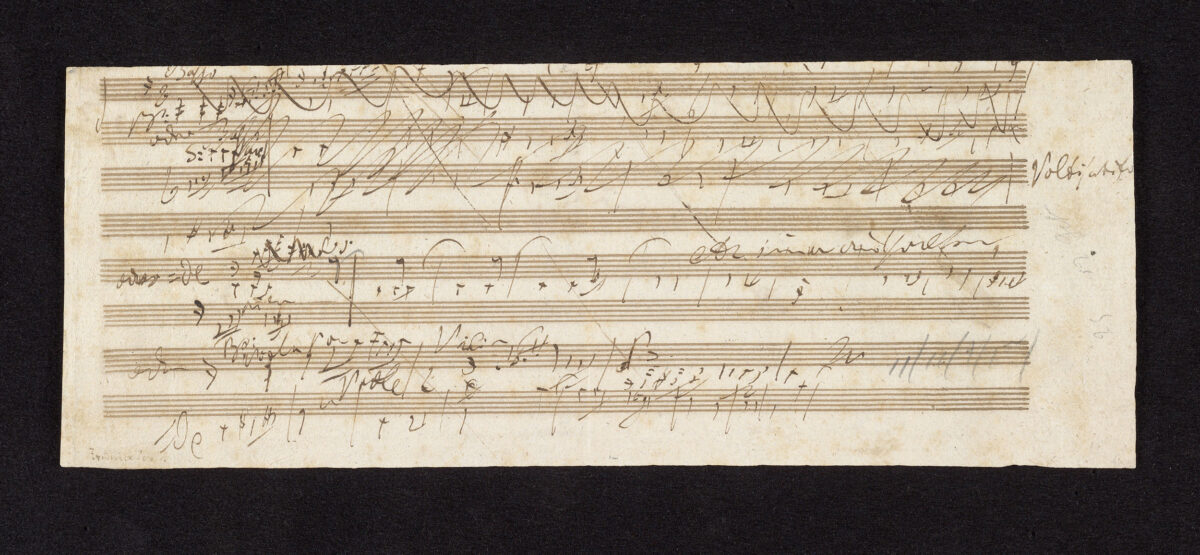When Ludwig van Beethoven put pen to paper to write his music, he transformed black ink and white paper into something far beyond the ordinary. In 1907, JP Morgan experienced this special dignity when he came across one of the great composer’s original manuscripts.
 “Ars longa, vita brevis” (Art is long, life is short), WoO 193, third set to music, 1825 (?), by Ludwig van Beethoven; Hippocratic text. Morgan Library & Museum. (Photo: Dannie and Hettie Heineman Collection)
“Ars longa, vita brevis” (Art is long, life is short), WoO 193, third set to music, 1825 (?), by Ludwig van Beethoven; Hippocratic text. Morgan Library & Museum. (Photo: Dannie and Hettie Heineman Collection)
Morgan was doing business in Paris when he heard that a businessman living in Florence, Italy had organized a concert playing Beethoven’s original manuscript for Violin and Piano, Sonata No. 10 in G Major, Op. . 96.
“Mr. Morgan thought it was really interesting,” Robin McClellan, assistant curator – curator of music at the Morgan Library and Museum, told me in a phone interview about the exhibition “Beethoven 250: Musical manuscript signed by Ludwig van Beethoven.”
Morgan quickly caught a train to Florence and showed up at the businessman’s home. He sat down and looked through the manuscript, which amazed him.
“The manuscript is a way to feel close to Beethoven,” McClellan said. Morgan purchased the manuscript and it became one of the first musical manuscripts in Morgan’s collection. It was displayed in an exhibition commemorating the 250th anniversary of Beethoven’s birth.
The exhibition includes a total of 11 works, divided into two parts: the first is the jumbled notes in musical drafts that the great composer recorded during his life; second, full multi-page manuscripts.
The exhibition allows you to connect with Beethoven, which can be a transcendent experience, because after all, his music was not simply for entertainment.

Early 19th century author, composer, and music critic ETA Hoffmann said of Beethoven, “His kingdom is not of this world.”
Beethoven, Mr. McClellan said, “is seen as someone who is connected to some spiritual truths that go beyond us ordinary people. Beethoven did his best and was able to teach or pass on that truth to us ordinary people.”
From chaos to beauty
McClellan did not study these specific manuscripts in detail before starting work at Morgan. But analyzing the range of musical ideas spread across Beethoven’s drafts in the first part of the exhibition is no easy task.
“I was struck by the disarray and chaos of [the notes],” McClellan said. That makes sense since they are not intended for public display. They are truly ‘notes to yourself.’”
But the necessary information is missing from Beethoven’s early notes. For example, sometimes it doesn’t specify whether notes are in the treble or bass clef or what the intended pitch is. Fortunately, McClellan was himself a composer, so he was able to analyze music expertly.
“It’s not like [the music] just pops off the page,” he said. “I have to do a bit of detective work to try to reconstruct what he actually meant here.”
 Violin and Piano in Sonata No. 10 in G Major, Op. 96, p. 36, 1815, by Ludwig van Beethoven. Morgan Library & Museum. (Morgan Collection)
Violin and Piano in Sonata No. 10 in G Major, Op. 96, p. 36, 1815, by Ludwig van Beethoven. Morgan Library & Museum. (Morgan Collection)
But McClellan’s arduous journey with Beethoven’s works seemed to pay off only when the great composer went through that creative process himself. In contrast to Mozart, whose music was often conveyed to him in its entirety, Beethoven had to work hard, McClellan said.
“Based on these sketches, one of the things [Beethoven] was famous for was how much work he put into getting the final result and how difficult and painstaking it was,” McClellan said. He is seen as a heroic figure, venturing into spiritual realms and then returning and imparting the profound truths he discovered.”
Through this arduous process, Beethoven unearthed a gem – a short melody or piece of music. The most famous example is the “da-da-da-daaa da-da-da-daaa” at the beginning of the Fifth Symphony. He repeats that short rhythm over and over throughout the piece. This is as opposed to performing one melody, then another, then another.
Beethoven’s music was often “based on a small melody or rhythm;” McClellan said “every part of a piece of music comes back to that little seed, the thing that unifies the music.” “It allows the listener to follow the emotion of the music. That little seed is like a character. Then it helps him tell a story as that character transforms and goes through different experiences.”
Entering the Divine realm
Beethoven not only influenced the practice of composition but also brought the metaphysical qualities of music into everyday life. In centuries past, a congregation would listen to hymns together in church, sharing a collective experience. But in the 19th century, at the height of the Romantic musical period, the experience became personal and private.
With Beethoven’s music, “as a listener, you can go deep within and let the music convey some profound truth or some deeper meaning to you personally,” McClellan said. . “You don’t need all the other elements of religion… When you can listen to Beethoven’s music, you can enter directly into that divine realm.”